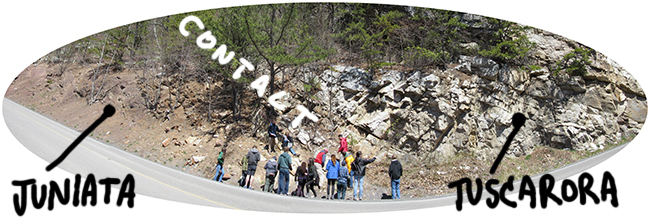5 October 2015
Trace fossils in the Juniata and Tuscarora Formations
Posted by Callan Bentley
Route 33 in Pendleton County, West Virginia cuts across the lower Paleozoic stratigraphic section. I went there this past spring on a sedimentology and stratigraphy field trip with the GMU sed/strat class. The trip was orchestrated by professor Rick Diecchio.
Here are some scenes from two of the stops – the upper Ordovician Juniata formation (red sandstones and shale intepreted as Taconian molasse) and the overlying Silurian Tuscarora Formation (thick quartz arenite equivalent to the Massanutten Sandstone).

The conformable contact between the two units is discernible at one point along the road, but what I would like to call your attention to today are some trace fossils from the two formations. In the Juniata, the planar bedding is cross-cut by deep Skolithos tubes, which Rick interpreted as an indication that the critters which lived in this area really needed to retreat from the high flow regime which deposited the planar bedding.

Same sample, with the contrast dialed up a bit, so the bedding and Skolithos stand out better:

In the Tuscarora, there were more bedding plane parallel traces, such as these Arthophycus:

Because of the relatively coarse substrate (sand, not mud), the fine details of the Arthrophycus (bumps and ridges) weren’t preserved especially well, but if held at the right angle to the light, a few of them emerged as discernible:

This will be the penultimate post from that field trip… I’m almost out of photos!


 Callan Bentley is Associate Professor of Geology at Piedmont Virginia Community College in Charlottesville, Virginia. He is a Fellow of the Geological Society of America. For his work on this blog, the National Association of Geoscience Teachers recognized him with the James Shea Award. He has also won the Outstanding Faculty Award from the State Council on Higher Education in Virginia, and the Biggs Award for Excellence in Geoscience Teaching from the Geoscience Education Division of the Geological Society of America. In previous years, Callan served as a contributing editor at EARTH magazine, President of the Geological Society of Washington and President the Geo2YC division of NAGT.
Callan Bentley is Associate Professor of Geology at Piedmont Virginia Community College in Charlottesville, Virginia. He is a Fellow of the Geological Society of America. For his work on this blog, the National Association of Geoscience Teachers recognized him with the James Shea Award. He has also won the Outstanding Faculty Award from the State Council on Higher Education in Virginia, and the Biggs Award for Excellence in Geoscience Teaching from the Geoscience Education Division of the Geological Society of America. In previous years, Callan served as a contributing editor at EARTH magazine, President of the Geological Society of Washington and President the Geo2YC division of NAGT.